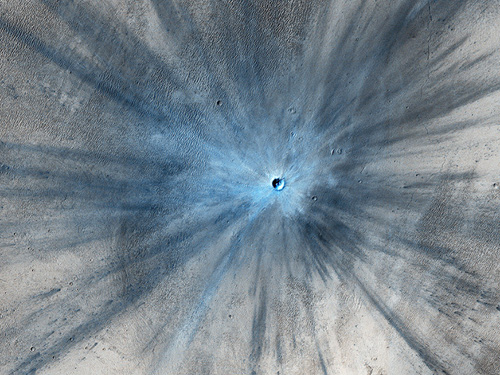NASA’s Mars Reconnaissance Orbiter HiRISE camera captured this stunning image of a fresh impact on the Martian surface.

NASA / JPL-Caltech / Univ. of Arizona
Of the hundreds of space rocks that bombard the Red Planet every year, some make spectacular pockmarks in Martian soil. This new crater is no exception. Its stunning radial blast pattern was imaged on November 19, 2013 by NASA’s Mars Reconnaissance Orbiter (MRO). The actual impact event occurred between July 2010 and May 2012, based on previous imaging of the area by MRO’s Context Camera.
The impact site is located only 3.7° above the equator, west of the dark plain Syrtis Major. MRO used its HiRISE camera to image the area, producing the striking portrait above. The crater spans about 30 meters (100 feet), and its vibrant blast zone of bright and dark hues stretches out as far as 15 km (9.3 miles). The landscape appears blue in this enhanced-color image because the impact blew away much of Mars’s reddish surface dust and blanketed the area in ejecta.
 2
2
Comments
Michael Coren
February 12, 2014 at 8:16 am
One thing I noticed when I first saw this image is that the crater appears to have a central peak or peak ring, features which (I believe) are generally associated with large, complex craters resulting from high energy impacts. However, its size (30m) indicates otherwise. Is there any speculation as to how these might have formed?
You must be logged in to post a comment.
Peter
February 12, 2014 at 9:50 am
Maybe it hit ice?
You must be logged in to post a comment.
You must be logged in to post a comment.